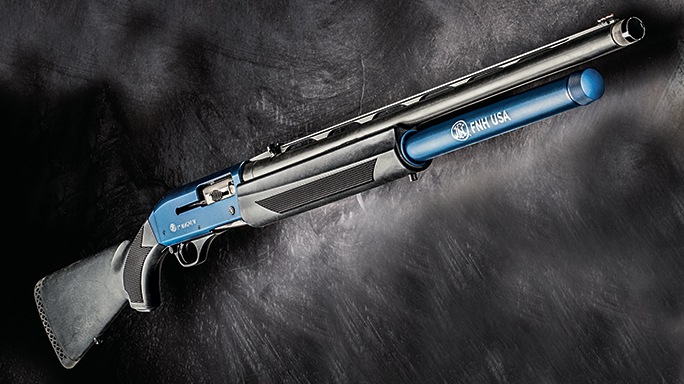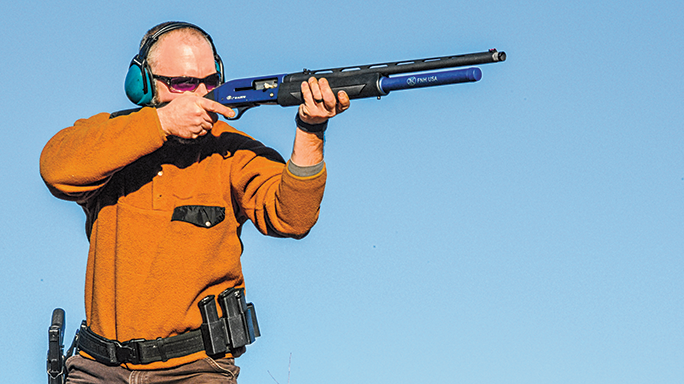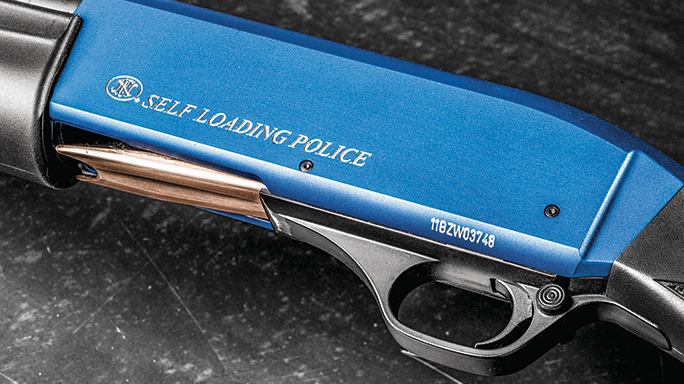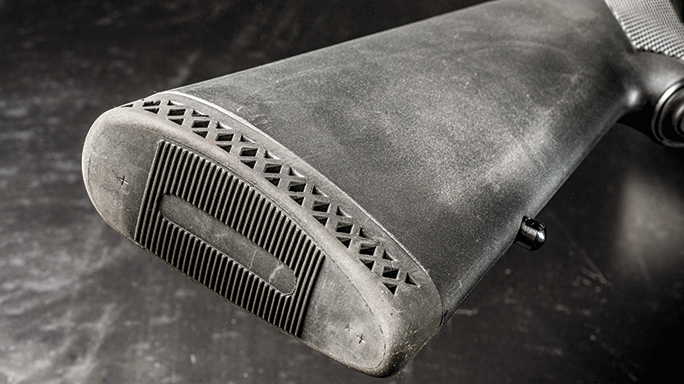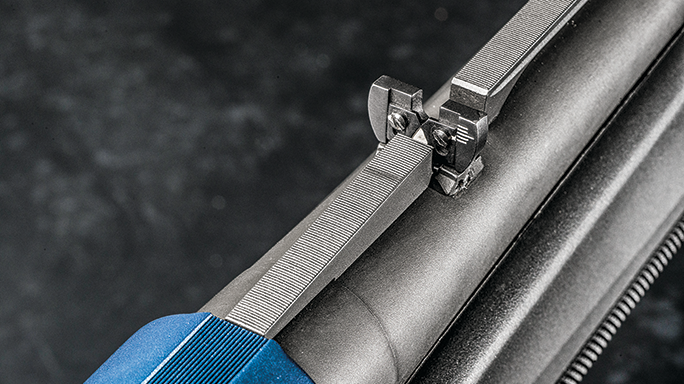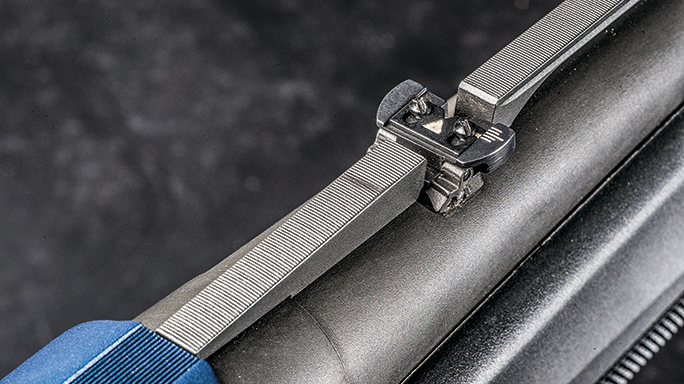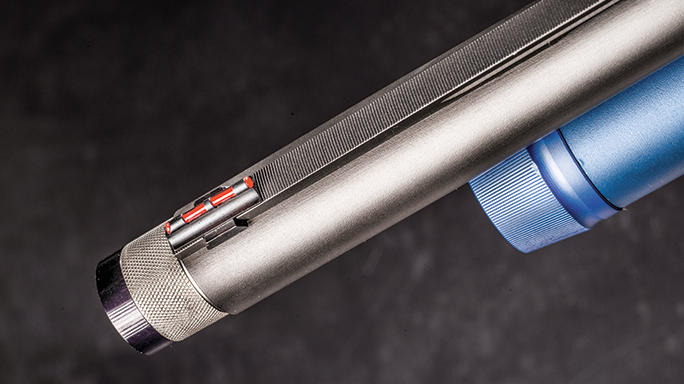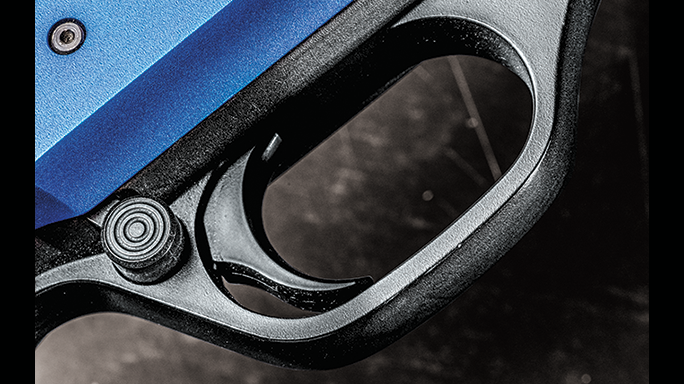With the berm cratered by nine slugs and our silhouette targets devastated with comically oversized holes, it was time to dust some flying clay—and give my shoulder a little break from high-brass punishment. The shotgun didn’t care what we fed it, but after 400 rounds, I sure did.
- RELATED VIDEO: New For 2016: FN America’s Civilian-Legal M249S
It was a good day, despite a few hiccups, and in the end I learned a thing or two. Here are those lessons, along with a breakdown of FN America’s 12-gauge Self-Loading Police (SLP) Competition shotgun.
Military Roots
Advertisement — Continue Reading Below
FN America is the stateside subsidiary of the Belgian Herstal Group, which traces its roots to Fabrique Nationale d’Herstal (or FN Herstal as it’s known today), a company founded in the late 19th century to produce rifles for the Belgian military. The company has had close relations with the Belgian government, and increasingly more European governments (and ours) ever since. Its facility in Columbia, South Carolina, is the U.S. place of manufacture for the military hardware sold to the U.S. government, including the M4/M4A1 and M16 rifles, the MK46, MK48, and M249 SAW machine guns, and even MK19 grenade launchers.
Through FN’s network of factories and assembling plants around the world, which it shares with fellow subsidiaries Browning and U.S. Repeating Arms (Winchester Arms), the company also produces a range of tactical shotguns. According to a barrel stamp, my sample SLP Competition was assembled in Portugal by Browning. It ended up in my hands for a very strenuous field test.
Self-Loading Police
Advertisement — Continue Reading Below
The Self-Loading Police shotgun debuted in 2008. After earning several prestigious awards, it made its way into the hands to local and federal law enforcement personnel, armed citizens and competitors. The M4-style front and rear sights (with the former affixed atop a post elevating it above the muzzle) helped accurately deliver slugs downrange, and the 6+1 capacity recommended it for true tactical work as a primary weapon.
Then came the SLP Tactical variant with a pistol-grip stock. Competitors, and some armed professionals, wanted a version with a little extra firepower, more minimalist sights (the M4-style sights obscure moving targets) and interchangeable chokes. Enter the MK I, with its 22-inch barrel, 8+1 capacity and a lack of M4-style sights in favor of a fiber-optic front sight and a rear leaf sight. The company also released a tactical variant with a pistol-grip stock—all of which led to the development of the SLP Competition.
Three Gunning
Advertisement — Continue Reading Below
The FN SLP Competition shotgun is a good example of gear updated from police and military hardware to civilian sporting equipment tuned specifically for fast-paced, high-volume shooting, as epitomized by the 3-Gun competitions regularly attended by FN America’s competition team. With their direct input, as well as feedback from other top athletes, FN’s designers set out to adapt the Self-Loading Police to the competitive world. They succeeded.
It’s normal for 3-Gun competitors to fire 100 or more rounds in a competition—and to have that round count include #7 1/2 birdshot, buckshot and slugs. Often on the same stage. Often alternating back and forth. Frequently at different ranges.
This would drive a traditional shotgun shooter mad and over-tax their equipment. Thus, successful 3-Gun shotguns must handle a magazine tube full of a mix of birdshot, slugs and buckshot, being able to fire all three types of ammo at a time without jamming. The FN SLP Competition shotgun I tested did all of this and a lot more.
Advertisement — Continue Reading Below
The SLP Competition retains the gas operating system found throughout the SLP line along with the rifle-style synthetic stock and generously oversized handguard with extremely positive checkering. New to this model is the vent rib that runs down the length of the 24-inch-long barrel for dissipating heat mirage. We sent a box of birdshot downrange as fast as we could fire and reload, and this vent rib worked as well as one could hope.
Also new is a flip-up rear leaf sight with graduated markings for helping get slugs to center-mass at longer ranges. There has been a move away from tactical-style sights on competition shotguns back towards the traditional- for-shotguns front bead (which cannot properly be called a sight). This has to do with field of view: Tactical-style sights can obstruct too much, especially when trying to track and lead a moving target, while the bead is ideal for the shotgun’s traditional role against moving targets. The SLP Competition has such a bead, and the rear leaf sight folds forward into an opening on the vent rib, where it rides out of the way as you blast moving targets. If you want it to help you put slugs downrange or take down poppers, you can easily flip it up with the thumb of your support hand.
Shotgun stages—indeed, whole matches—can be won through shotgun reloading speed. There are few things slower than reloading a shotgun, but competitors using the “load two” or “quad load” technique can cut this time drastically. To help them, the SLP Competition has an enlarged loading port, and the cartridge lift is milled so you can push your thumb into the magazine tube to seat the last cartridge, and retrieve your thumb again without snagging yourself. These details are absolutely crucial to a modern 3-Gun shotgun, and work wonderfully on the SLP Competition.
Advertisement — Continue Reading Below
The SLP Competition’s design is extremely well thought out from first to last. But how does it shoot?
Torture Test Survivor
Testing began at the trap and skeet range, where the SLP Competition came up to bear like a dream and tracked targets smoothly. The receiver is made of milled aluminum for a balance of strength and light weight, and the light weight resulted in fast handling and very little overswing.
Advertisement — Continue Reading Below
The SLP strikes many balances. Lightweight shotguns kick like mules, which slows down follow-up shots. Heavy shotguns push more than kick, but are slower in handling. By using its short-stroke gas operating system, FN has engineered a system that actually soaks up some recoil energy, lessening the perceived recoil, while the synthetic stock and handguard and aluminum receiver help lighten the overall shotgun. That’s how you get a 45.6-inch-long shotgun that weighs only 7.5 pounds, and which magically doesn’t kick like a mule. This was particularly appreciated as I eclipsed 250 rounds on the trap range in under two hours.
My test SLP Competition shipped with an Invector Plus extended choke tube in Improved Cylinder size, which should be capable of handling any of the shot and slugs that the 3-inch magnum receiver can chamber. It’s not the best choke for trap—a modified or light-full choke would have been better—but it’s dynamite for skeet and blasting the kinds of clay targets frequently encountered at 3-Gun matches. With the Invector Plus choke system, you can switch chokes to suit individual stages.
Another balance is found in how the SLP’s operating system handles the pressures associated with high-brass, 3-inch magnum cartridges as well as low-brass birdshot cartridges without users having to change out any pistons, springs, plugs or other components. The SLP Competition chewed through a number of Federal high-brass #6 hunting loads (which are great for swinging heavy spinner targets) along with all of the slugs and buckshot we fed it.
Advertisement — Continue Reading Below
The Winchester, Federal and Remington slugs still kicked pretty hard but flew straight and printed groups that suggest excellent accuracy beyond our test shooters’ abilities.
A significant amount of buckshot went downrange from Winchester, Federal, and some odds and ends from the gear bag, all to tremendous effect. At 10 yards, the pellets generally stayed in a 6-inch circle—big enough to give you some margin of error on steel plates and tight enough to give you multiple steel-toppling hits when you do your part while firing.
I loaded a few magazine tubes with a random combination of slugs, buckshot and birdshot—a cringe-worthy test for any upland wingshooter’s gun, but a good representation of a day at the range for a 3-Gun shotgun—and was happy to see that even mixed loads from mixed manufacturers fired with a reliable cadence.
Advertisement — Continue Reading Below
FN’s previous SLP models ship with two gas pistons—one for target loads and light-recoiling defense cartridges, the other for full-power loads up to 3-inch magnums. The SLP Competition, though, ships with a middle-ground “competition” piston—basically the heavier-load piston designed to work with the hotter end of the lighter-load spectrum as well. This explains how it handled the 3-inch magnum turkey loads we put through it along with 1,600-fps slugs on down to the Federal target loads that push 1 ounce of shot downrange at approximately 1,250 fps.
The only loads it didn’t like were cartridges less powerful than the manual suggests: birdshot loads with 1 ounce of shot at only 1,180 fps.
My normal testing protocol for firearms involves evaluating guns as they come straight from the manufacturer without any special tweaking—just a gun in its box, the same as you would get at the store when you buy one new. That preserves the validity of my tests. This shotgun appears to have come to me after some prior usage for most likely testing or a photography shoot. As a result, the plugs in the receiver (that fill the threaded holes where you can mount an optic rail) were not installed.
I discovered during testing that they do need to be installed, as this can allow a surprising amount of gas to be exhausted from the open holes, especially when firing high-brass shells in the SLP Competition. Installing these plugs closes up the openings to solve the issue. Of course, this does not at all reflect what you would find in a new-out-of-the-box SLP that would come with them installed.
Built To Win
Internally, the SLP Competition has a very simple, hearty design—we didn’t clean it at all over 500 rounds, and it worked flawlessly no matter the type of ammunition we loaded, how fast we fired it, how dirty it got, or how hot the parts got with rapid fire. That’s some truly awesome performance.
- RELATED STORY: FN Sentinels: 8 Battle-Proven ARs From FNH USA
Externally, the matte blue anodized finish on the receiver and magazine tube extension looks great and can withstand the weather, and the synthetic furniture laughs at rain, dust and hard use. This is a shotgun you can dump into a 3-Gun barrel without worrying if you’ll bend the magazine tube—it’s seriously robust, protected by an aluminum sleeve and interfaces with a beefy gas port / brace that’s welded to the barrel—or scratch the furniture. It’s designed to be abused, as only action shooting competitions can abuse a shotgun, and launch some serious payloads quickly and accurately. And it survived our field evaluation, de-spite me not reading the manual before hitting the test range. That’s an accomplishment for any gun.
For more, visit fnhusa.com or call 703-288-3500.
Specifications
- Gauge: 12; 3-inch chamber
- Barrel: 24 inches
- OA Length: 45.6 inches
- Weight: 7.5 pounds (empty)
- Stock: Synthetic
- Sights: Fiber-optic front, flip-up lead rear
- Action: Semi-auto
- Finish: Hardcoat anodized blue
- Capacity: 8+1
- MSRP: $1,449
